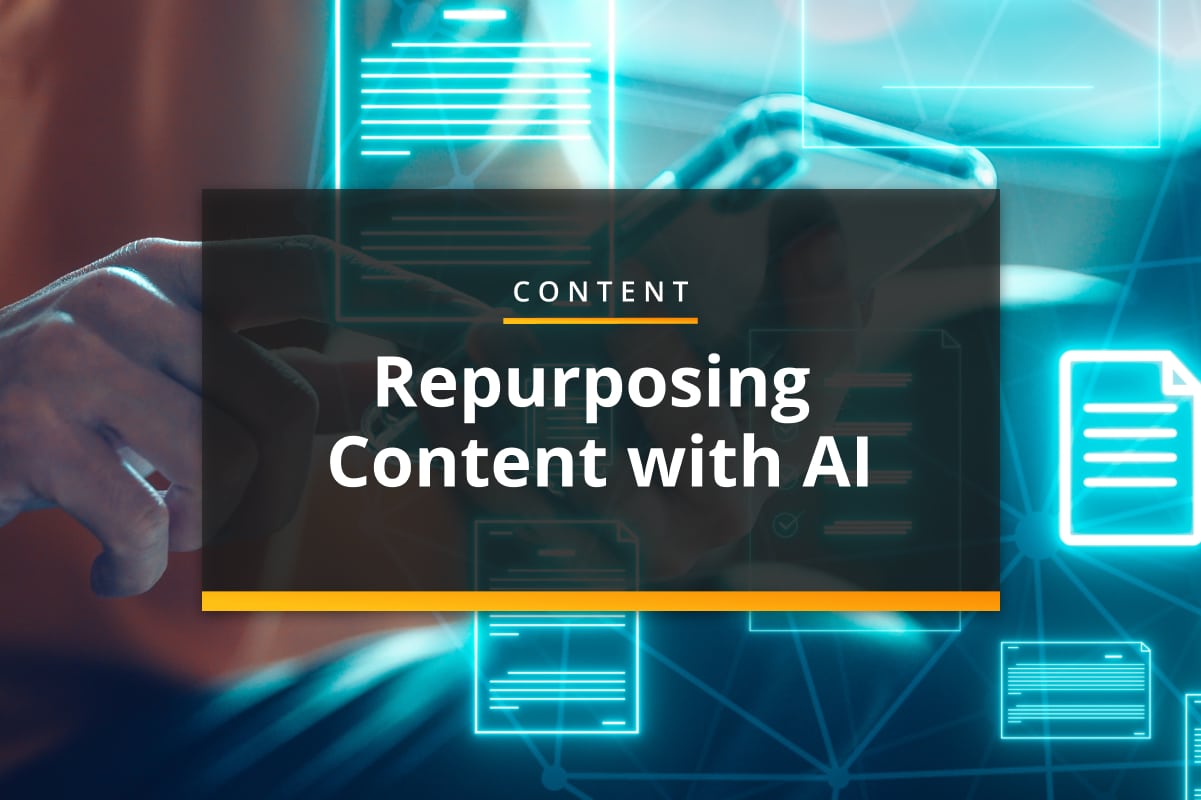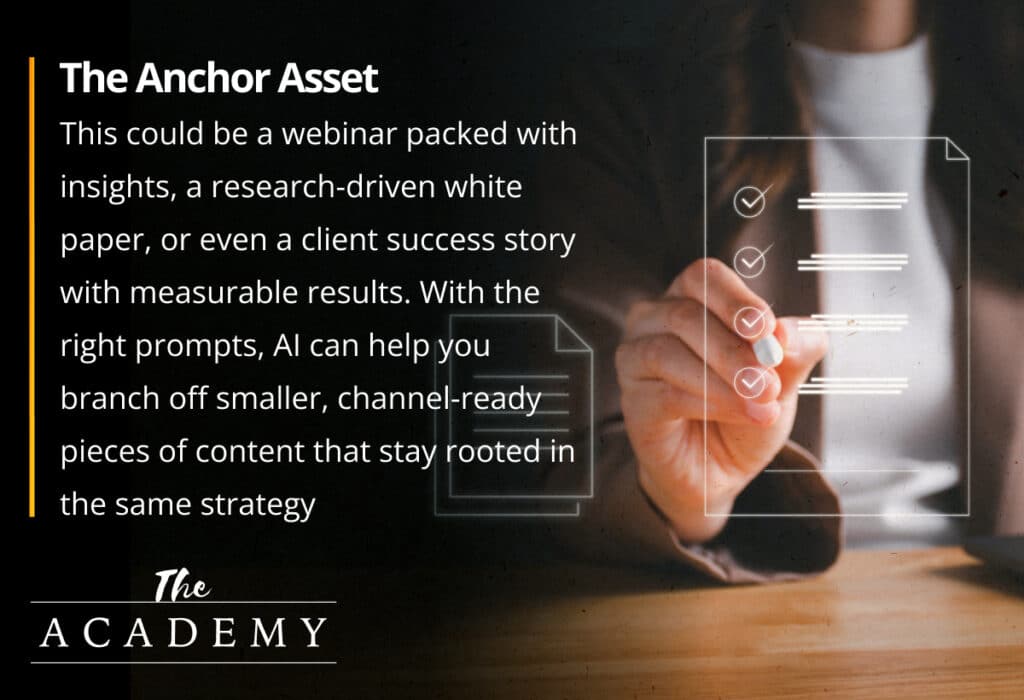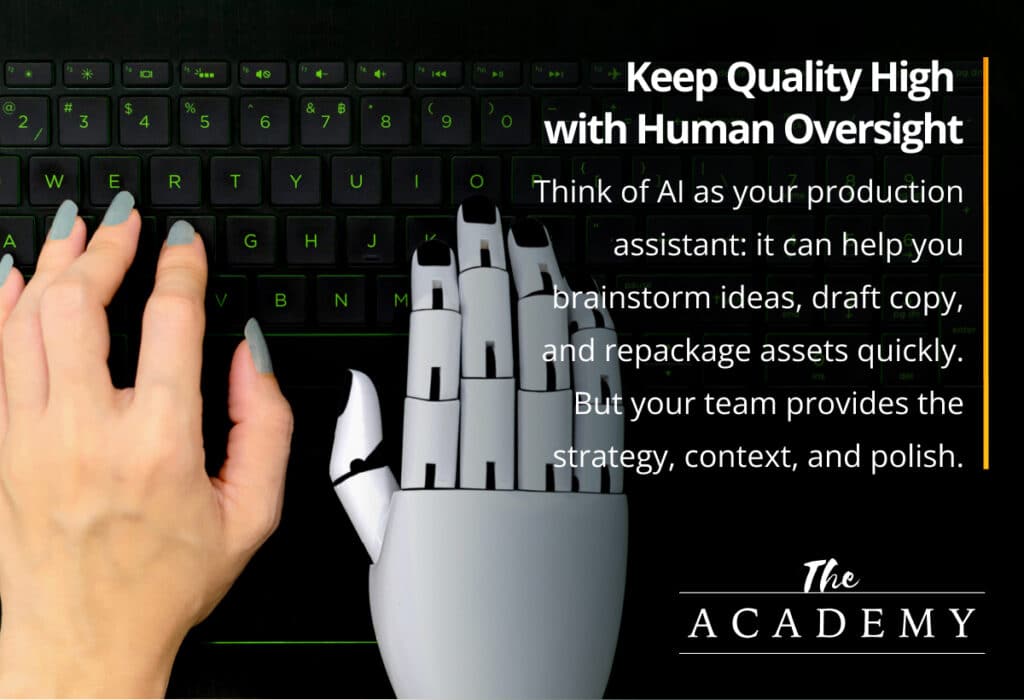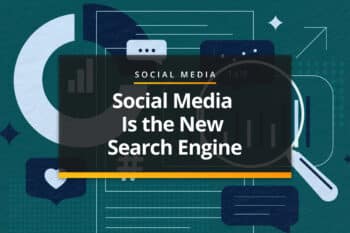
Marketers often invest heavily in creating one “big” piece of content (like a white paper, webinar, or landing page). Imagine taking that one piece and instantly spinning it into a month’s worth of blog posts, social posts, and emails. AI tools can help break that single asset into multiple formats, tailored for different channels, audiences, and buyer journey stages—without burning out your team. That’s the power of AI-driven content repurposing: one asset, many outputs, and endless opportunities to engage your audience.
Keep reading to learn how you can harness the power of AI tools like ChatGPT to do more on the fly with your existing content.
Making AI Feel More Human with Context and Established Voice
ChatGPT will never feel like more of a lifeless robot than if you ask it to write something for you cold, without any context, direction, or examples to work from. It will give you a generic, surface-level response that doesn’t feel like your company’s voice.
But once you start layering in various rules, style guidelines, buyer personas, phrases you like and don’t like, past pieces of content that have been successful, and more, ChatGPT can start doing more for you that actually feels like you.
Getting Started: The Anchor Asset

Not every piece of content is worth repurposing. To get the most from AI, start with a “pillar” asset—something that’s deep, valuable, and strategically tied to your audience’s needs. This could be a webinar packed with insights, a research-driven white paper, or even a client success story with measurable results.
Think of this anchor asset as the tree trunk. With the right prompts, AI can help you branch off smaller, channel-ready pieces of content that stay rooted in the same strategy. Instead of constantly trying to create something new from scratch, you’re extending the life and impact of the content you’ve already invested in.
Breaking It Down by Content Format
Once you have your anchor asset, AI can help you spin it into the right formats for each channel in your marketing mix. A single white paper, for example, could become:
- Blog Posts: Pull out key sections and expand them into standalone articles optimized for SEO.
- Social Media Snippets: Create a series of short, punchy posts using quotes, stats, or takeaways tailored for social media channels.
- Email Campaigns: Turn highlights into a nurture sequence that delivers bite-sized value directly to your subscribers’ inboxes.
- Infographics or Visuals: Draft text for graphics that summarize big ideas in a more visual, shareable way.
- Video Scripts: Use AI to generate outlines or dialogue for explainer videos or short social clips.
The real advantage is speed. What used to take days of brainstorming and drafting can now happen in a fraction of the time. Oftentimes, the hardest part of content creation is just getting started, getting something down on paper. So once you have a draft to work from, you can then focus on refining, editing, and ensuring everything aligns with your brand’s voice and goals (aka the human touch).
Map Repurposed Content to the Buyer’s Journey
It’s important to keep in mind that repurposing isn’t just about creating more content. It’s about creating the right content for the right stage of the buyer’s journey, which requires a deeper understanding of your customers.
AI makes it easier to tailor your anchor asset into formats that meet your audience where they are:
- Awareness Stage: People are just discovering they have a problem or opportunity. From your anchor asset, AI can draft blog posts, quick social updates, or even a short checklist that introduces key ideas and builds trust.
- Consideration Stage: Prospects are evaluating options. Here, you can use AI to create comparison guides, FAQs, or explainer videos that reframe sections of your white paper or webinar in ways that help them dig deeper.
- Decision Stage: Buyers are close to making a choice. This is where AI can help transform case studies into testimonial snippets, email spotlights, or one-page summaries that highlight results and reassure them they’re in good hands.
When you map content this way, you’re not just recycling. You’re strategically extending your message so it speaks to someone scrolling LinkedIn, someone researching solutions, and someone ready to sign a contract—all from the same original piece. That’s how AI-driven repurposing fuels the flywheel: attract, engage, and delight at every turn.
Keep Quality High with Human Oversight

AI is powerful, but it’s not perfect. Left unchecked, it can drift into generic language, make factual mistakes, or miss the emotional nuances that make content resonate. That’s why human oversight is essential.
Think of AI as your production assistant: it can help you brainstorm ideas, draft copy, and repackage assets quickly. But your team provides the strategy, context, and polish. You know your audience, your brand’s voice, and the subtle cues that make a message feel trustworthy and authentic.
Before publishing, review everything AI produces for:
- Accuracy: Fact-check numbers, names, and technical details.
- Voice and Tone: Ensure it reflects your brand’s established style and doesn’t feel robotic or off-key.
- Relevance: Confirm it speaks directly to your buyer personas and their current challenges.
- Strategy Alignment: Double-check that each repurposed piece supports your broader marketing goals.
The most effective marketers use AI for scale and efficiency while leaning on human judgment to maintain quality. When you combine both, you get content that’s fast to produce and meaningful to your audience.
Start Doing More with What You Have
To use AI successfully for content creation, it all comes down to what you can “feed” it, as well as ensuring you don’t cut out the human touch. Should you use ChatGPT to create something from nothing? No. But can you use it as a tool to help draft something based on a carefully crafted piece of content and many other valuable inputs? Yes. Start making the most of that asset you spent so much time (or money) on creating!
Most Popular Articles

Seeing Favicons in Your Google Search Results? Here’s Why…
Have you noticed anything different in your Google Search results lately? Google added tiny favicon icons to its organic search results in January. It was…

Business Growth and Digital Marketing News & Tips 11-17-24
Are you encouraging and rewarding innovation? Lee Cockerell is the former Executive Vice President of Operations at Walt Disney World. A lover of traditional red…

Business Growth and Digital Marketing News & Tips 11-27-24
A culture of gratitude "Feeling gratitude and not expressing it is like wrapping a present and not giving it." – William Arthur Ward Beyond being…








